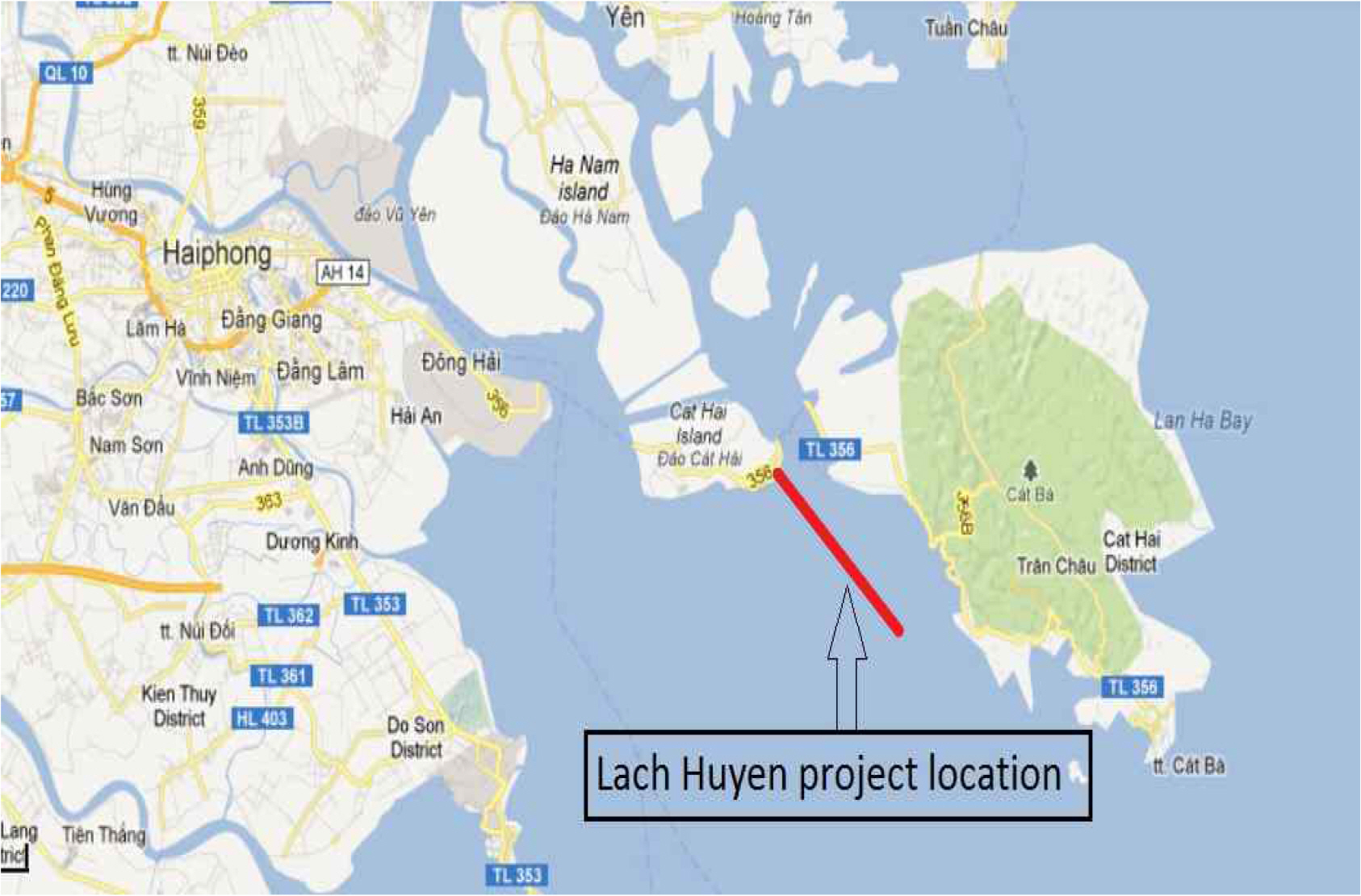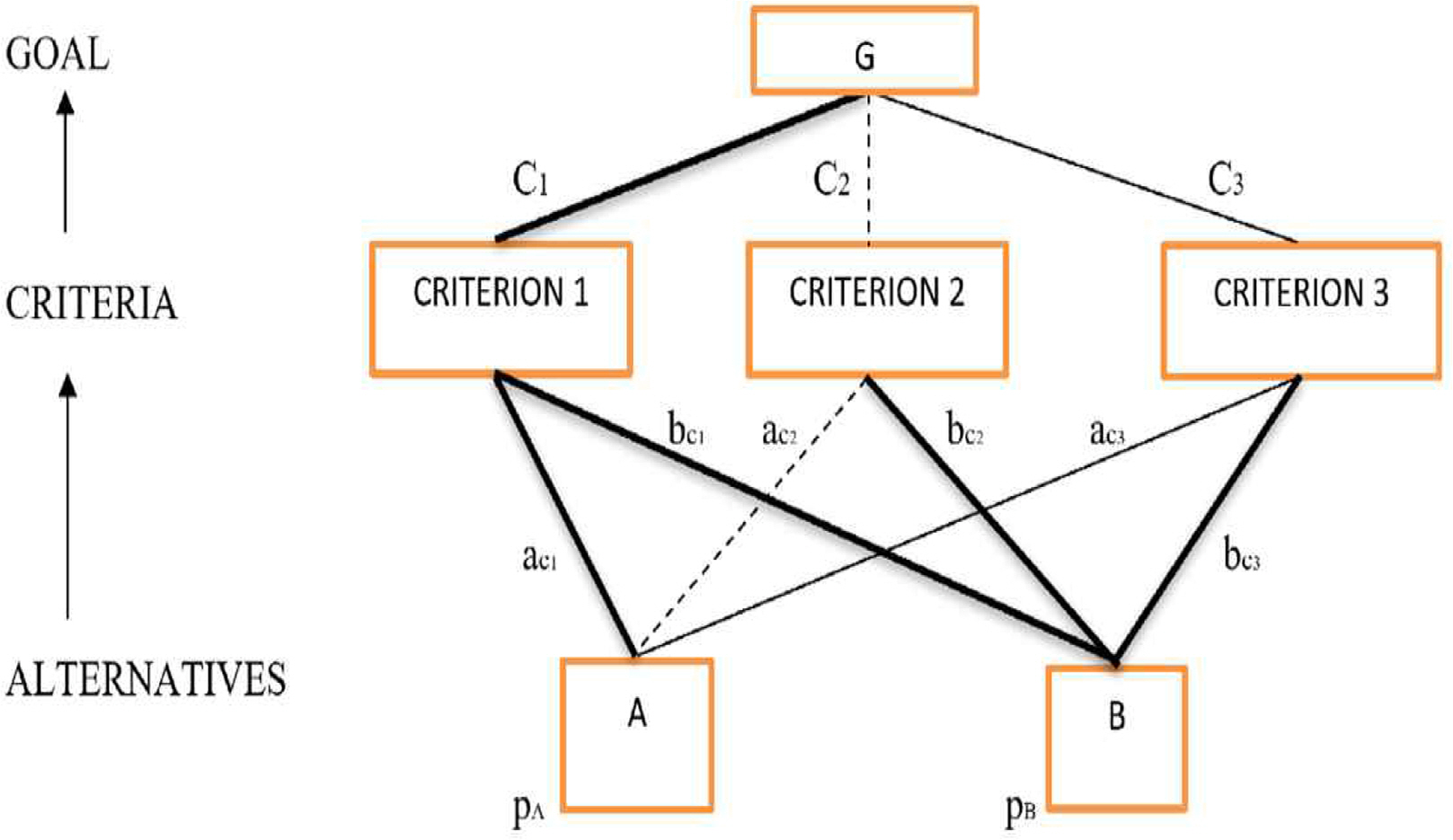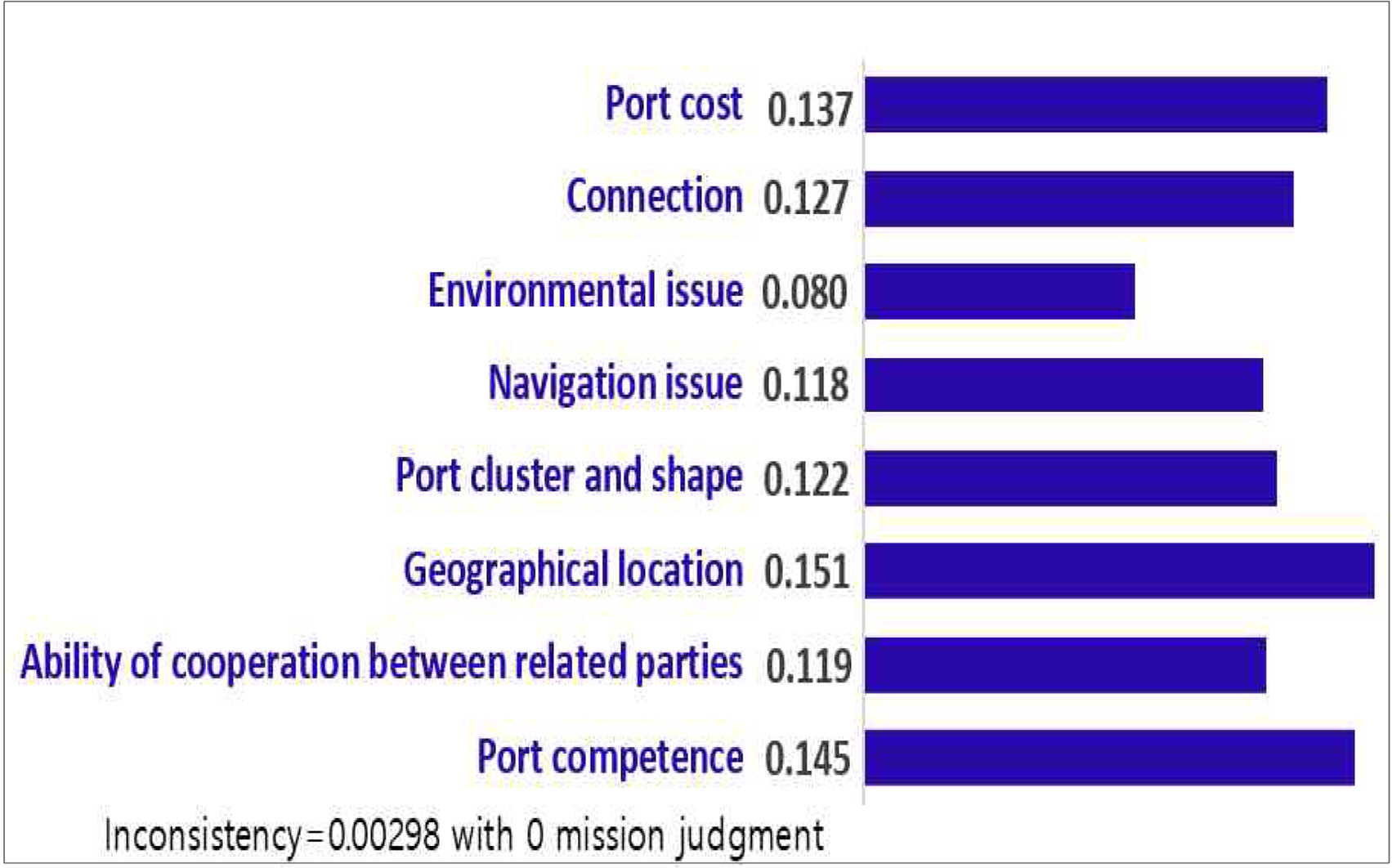1. Introduction
In the past 10 years, the seaport industry has grown rapidly and has played an important role in the global integration process of Vietnam. Located next to the South China Sea, on the maritime route from the Strait of Malacca to the Luzon strait and the Taiwan Strait(LaFond, 2020), Vietnam has an advantageous location to welcome ships with large capacity and tonnage, as a destination as well as for transshipment. But while the demand for freight transport increases with proximity to an important sea route, a lack of logistics facilities makes it difficult to accommodate large ships, impairing a countryŌĆÖs competitiveness. Vietnam is a country with a long coastline, so it needs to exploit all of its natural advantages. Ability to accommodate large ships has many important implications for VietnamŌĆÖs maritime industry and economy. Accommodating large ships and operating a container port in Hai Phong would be a milestone for Vietnam in the development of container shipping services. When mother ships with a tonnage of hundreds of thousands of tons can continuously call in Vietnam, it gives import-export businesses a great advantage in logistics costs. Previously, export and import from Vietnam to EU and US usually transshipped by small vessel in some country like Malaysia and Singapore, and then connect to mother ship(Delegation of the European Union to Vietnam, 2019). However, when a mother ship can call at Hai Phong, cargo can be loaded and unloaded directly to and from the mother ship, which will go on to call at major ports on the east-west maritime routes. Direct transfers by mother ships can take advantage of the time to increase the volume of exports going on the same voyage to the port. When a seaport has the capacity to accommodate large ships and is located on the main routes, it has an opportunity to become a regional transshipment hub(Kavirathna et al., 2018), creating a reason for shipping lines to use seaports in Hai Phong as a link in the global shipping chain. If a new deep water seaport is built in Hai Phong, it can improve shipping efficiency as well as competitiveness in transshipment both nationally and internationally, especially in the northern provinces of Vietnam. To these ends, the government of Vietnam has developed basic plans to build the deep water seaport and has started construction of deep water seaport called Lach Huyen. There have been related studies(Buyukyaz─▒c─▒, 2003; Hlali and Hammami, 2017; Talley, 2011; Tai and Hwang, 2005) that weigh critical factors in building a new deep seaport system, but there are many conflicting opinions on this issue. This study contributes to the debate by determining what the critical factors and their priorities are. The remainder of this paper is organized as follows: Part 2 introduces an overview of the seaport in the northern Vietnam. Part 3 presents a review of previous studies. Section 4 describes the methodology. A case study is presented in Section 5, and the conclusion is presented in Section 6.
2. The current situation of the seaports in the northern Vietnam
The north of Vietnam is gradually becoming a gateway to electronics, automation, and precision engineering. Samsung Corporation (Korea) has built a mobile phone manufacturing factory in this area. The Deep C industrial park near Lach Huyen port attracts about 80% of Vietnamese and international companies. Nghi Son, VietnamŌĆÖs second oil refinery, went into operation in mid-2018. VietnamŌĆÖs exports to North America and Europe currently pass through Singapore or Hong Kong. Mitsui O.S.K. Lines, a Japanese shipping company, plans to open a direct service from Lach Huyen to North America. Many companies have arranged facilities around Lach Huyen. Vingroup are building car factories in the nearby economic zone. The group plans to sell 100,000 to 200,000 vehicles by 2019 and export them to Southeast Asian countries. In the northern region of Vietnam, maritime cargo traffic volume reached 130 million tons in the year 2020. These figures will exceed the cargo handling capacity of both Hai Phong and Cai Lan ports (total capacity of 75 million tons) located in the northern region. There is an urgent need to boost the cargo handling capacity of ports located in the northern region. In addition, the highway system of Hai Phong-Hanoi, Hai Phong-Quang Ninh, Hanoi-Thai Nguyen, Hanoi-Lang Son has created a modern and smooth traffic network in the north, shortening the traffic time from the northern provinces to Dinh Vu Industrial (Dinh Vu-Cat Hai Economic Zone) and international ports. It can be seen that the Lach Huyen port cluster plays a particularly important role in VietnamŌĆÖs seaport system.
Port of Hai Phong is a general port to cover the increasing demand for cargo loading and unloading by sea of provinces, cities, and industries in the northern key economic region, especially the economic triangle of Hanoi-Hai Phong-Quang Ninh. In the long term, Lach Huyen Port is poised to attract a large share of international and regional transshipment.
Therefore, in order to meet the freight transport demand, the construction of a new deep-water port system in the north is necessary. The Lach Huyen area was chosen as the site because of its geographical location and many other factors as shown in Fig 1.
3. Literautre Review
Previously, researchers have studied and analyzed the importance of deep seaport systems. Tang and Zhan(2006) point out that the construction of an international shipping hub is one of the main goals of urban development. Their strategic goals were to build an international shipping hub, so a series of deep-water berths were already being built based on their report. Therefore, for the north in particular and Vietnam in general, the construction of a deep seaport is necessary for the optimal economic and urban development of the area.
AHP has attracted the interest of many researchers, mainly due to the mathematical features of the method and the fact that the data entry is fairly simple. Its simplicity is found in the pair-wise comparison of the alternatives according to specific criteria.
In recent years, there have been several studies on deep water ports using the Analytic Hierarchical Process (AHP) method(Zavadskas et al., 2015) and applied AHP to achieve criteria weights in a group decision problem. Their results bore on the need to meet economic needs by developing a deep seaport in the Klaipeda region. This issue involves a multitude of requirements and uncertain conditions that must be considered simultaneously. They presented their model as a form of decision support that can be exercised with regard to any particular port or similar site selection. Akbari et al.(2017) also used AHP to determine the importance of criteria when studying the logistics capabilities of offshore wind ports, namely physical characteristics, connectivity, and the layout of the port, in support of the installation and operation and maintenance phases of offshore wind projects. The AHP method was then applied in a case study as a decision-making tool to allow planners to assess the suitability of some ports for an offshore wind farm of in the U.K.ŌĆÖs North Sea. The results provided the present author with a model on which to base port selection based on calculated and graded indicators.
In Vietnam, both domestic and international trade has grown dramatically over the past fifteen years. The volume of goods through Vietnamese ports has therefore increased rapidly, but the port is currently operating beyond its maximum designed capacity. Congestion is one of the main problems, and expansion is not feasible due to the limited water depth of the river. In addition, maintenance costs are very high because of the huge amount of sediment in the channel. The forecast is that the port will no longer handle the expected throughput volume in the near future. The construction of seaports with modern infrastructure and synchronous information technology applications will help load and unload goods, quickly release ships, and improve the efficiency of seaport services.
The evaluation of infrastructure projects at major seaports often requires taking many aspects into account, including environmental, economic and social factors. Infrastructure projects face risks of budget constraints, increased competition for land, and environmental pressure. As there has been no comprehensive and complete study of deep-water ports around Hai Phong, this study examines the proposed development and its viability from a technical point of view.
4. Methodology
The AHP is one of the more widely used multi-attribute decision-making methods. To process alternatives, AHP uses a hierarchy or network to represent a decision and then develops preferences for alternatives across the entire system based on the decision makerŌĆÖs judgment. AHP analysis is usually performed with a small group of experts who are able to perform pair comparisons of decision criteria(Pynnonen, 2006).
The purpose of this paper is to determine the critical factors and construction requirements and weigh the importance of factors for a new deep-water seaport system in the Lach Huyen area in northern Vietnam. This problem consisted of multi-criteria decision-making model, and this paper proposes the AHP to solve this problem (Yeo and Song, 2003; Zavadskas et al., 2015; Akbari et al., 2017)
This study used this method in both subjective and objective evaluation criteria (quantitative and qualitative). It obtained a ranking order of the alternatives and their relative positions measured on a scale(Ko, 1980; Sule, 2001).
AHP includes 4 steps as follows: The first step is to establish a hierarchy of decisions by dividing decision problems into a hierarchy, in which the hierarchy consists of interrelated decision factors.
The second step is a pairwise comparison in which a pairwise comparison of the determinants receive input. If the hierarchy consists of n comparative elements, then n(n-1)/2 comparisons are required. In studies using basic analytical hierarchy, a nine-point scale is used.
In order to get the criteria weights, the calculation processes are as follows(Yeo and Song, 2003).
With n being the number of criteria and the criteria being A1,ŌĆ”An and their original weights W1,..., WN the relative comparative value of the weight of Ai and Aj, aij satisfies the formula
The constitution of a comparison matrix A is shown in Equation (2), by use of aij mentioned above.
When this comparison matrix A is multiplied by the vector of weights (W), vector nŌłÖw is obtained. That is,
To express (2) in detail. then, we have :
In step 3, one uses the eigenvalue method to estimate the relative weights of the decision elements.
In the AHP method, the Consistency Ratio (CR) is calculated to measure the consistency of the criteria compared with large samples of a completely random criterion. If the CR is less than or equal to 0.1, the survey will be accepted. If the CR is greater than 0.1, the analytical criteria are not valid and must be rerun(Coyle, 2004).
One can check for consistency by measuring the CR with the help of the method-related Consistency Index (CI),
where ╬╗max is the maximal eigenvalue and n is the matrix size.
The consistency ratio, the ratio of CI and RI, is given by :
In the final step, one aggregates the relative weights of decision elements to arrive at a set of ratings for the decision alternatives.
5. Case Study
The evaluation criteria were selected from previous research as shown in Table 1 and confirmed by in-depth interview of the experts who have been working for Port of Hai Phong (Kumar et al., 2017). The evaluation structure was consisted of 8 principal criteria and 23 detailed criteria.
The questionnaires were distributed and conducted from August 8, 2020 to August 24, 2020. Experts were selected from a logistics company, shipping agents and port staffs in Hai Phong city. The participants had 2 to 15 yearsŌĆÖ experience in the relevant field and therefore could give comprehensive insights into the construction of a new deep-water port system in the Lach Huyen area. 150 questionnaires have been sent, 60 have been collected, and the response rate is 40%.
The first step in establishing the AHP model is to define the criteria that will be used. Expert Choice 11.5 software was used to calculate the principal criteria and sub-criteria. The table 3 below shows the weight results and the priorities assigned to the criteria and sub-criteria.
The degree of consistency of all criteria (CI) was 0.00298 and the Consistency Ratio(CR) was 0.00211. As this is less than the critical value of 0.1, it confirms that the questionnaire was effective and the results were consistent.
Of the results summarized in Table 4, ŌĆ£Geographical locationŌĆØ (0.151) ranked as the most important criterion, affected by additional sub-criteria ŌĆ£direct sea route with mega vesselŌĆØ and ŌĆ£good liner connectivity indexŌĆØ In the total ranking of 23 sub-criteria, the sub-criterion ŌĆ£direct sea route with mega-vesselŌĆØ (0.061) was judged the most important.
The principal criterion ŌĆ£port competenceŌĆØ (0.145) ranked in the next position. It was composed of sub-criteria such as ŌĆ£competitiveness with other seaports in the South China Sea,ŌĆØ (0.058) ŌĆ£competitiveness with other local seaportsŌĆØ (0.057) and ŌĆ£intra-port competitionŌĆØ (0.049). Thus we can conclude that port competence is still one of the most important considerations for building a deep water seaport, while the criteria ŌĆ£port costŌĆØ (0.137), ŌĆ£connectionŌĆØ (0.127) and ŌĆ£port cluster and shapeŌĆØ (0.122) followed behind.
6. Conclusion
Priority and weights of the evaluation criteria were calculated using the AHP using the Expert Choice software.
The results were as follows. The principal criterion ŌĆ£geographical locationŌĆØ (0.151) was ranked as the most important criterion for building a new deep-water port system, which is affected by the sub-criteria ŌĆ£direct sea route with mega vesselŌĆØ and ŌĆ£good liner connectivity index.ŌĆØ As mentioned above, a lot of logistical cost can be saved through the construction of a new deep-water port system in the Lach Huyen area when it is connected to routes with large ships. Moreover, as the principal criterion ŌĆ£port competencyŌĆØ (0.145) ranked second, we can conclude that having good competitiveness will bring many benefits to the port and the region. Therefore, it is necessary to improve the competitiveness of seaports with ports in the South China Sea, and throughout the country.
The originality of the paper is that the main factors of a new port construction have been clearly identified through analysis and it will help decision-makers choose the best criteria know as examine the advantage and disadvantage of other criteria.
The results give some implications for both the port industry and academics. Regarding industrial implications, port-related stakeholders can benefit from this paper in the following ways. (1) As ŌĆ£direct sea route with mega-vesselŌĆØ is ranked as the most important criterion, followed by ŌĆ£competitiveness with other seaports in the South China Sea,ŌĆØ It is clear that saving logistics costs and enhancing port competitiveness with other ports in the same high seas are always essential to consider. (2) In addition, highly regarded criteria such as geographic location and port capacity or port cost should be taken into account. (3) The established evaluation framework can be used for to make sound judgments in port construction. For academics: (1) the factor structure of construction of a new deep-water seaport system in Lach Huyen area Vietnam is established; (2) a calculation process using priorities of critical factors using AHP is suggested.
In considering critical factors in construction of a new deep-water seaport system and their priorities, this paper may serve as a stepping-stone. Some factors have yet to be considered, such as a shipŌĆÖs automation and digitalization. Also, only port-related stakeholders participated in the questionnaire process. In the future, the evaluation factors should be broadened and other stakeholders such as shipping companies, forwarders, and logistics companies should be added as respondents. In addition, the respondents may have difficulties to reply the AHP questionnaires which consisted of n(n-1)/2 questions. This causes the inconsistency of answer. This weakness of AHP will be improved using more advanced methodology.








 PDF Links
PDF Links PubReader
PubReader ePub Link
ePub Link Full text via DOI
Full text via DOI Download Citation
Download Citation Print
Print






